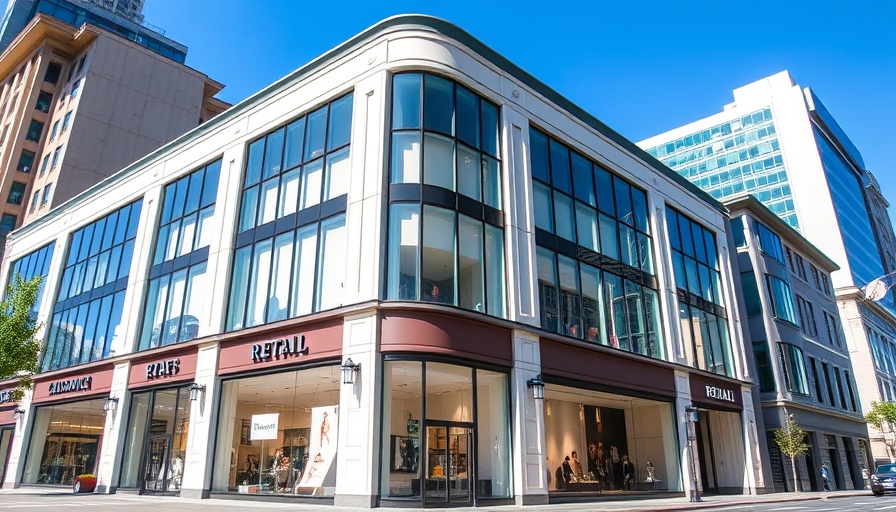
The Texas Investor Making Waves in San Francisco's Retail Market
In a bold move signaling optimism for San Francisco’s retail landscape, Texas-based investor Douglas MacMahon has acquired One Union Square, a seven-story commercial building at the bustling corner of Geary and Stockton streets. This strategic purchase marks yet another significant investment in the beleaguered market since the pandemic prompted a downturn.
The property, which was in foreclosure, sold for $42.5 million, a stark contrast to its 2013 sale price of $95.8 million. MacMahon's investment comes on the heels of a flurry of acquisitions, including a four-story building previously owned by the Burberry parent company and multiple retail properties in Hayes Valley. According to MacMahon, these investments reflect a long-term belief in San Francisco’s potential as a robust real estate market.
Perspective on Commercial Real Estate in San Francisco
San Francisco's retail market is still grappling with aftershocks from the pandemic, evidenced by numerous vacancies in prestigious areas like Union Square. However, experts like Sandy Lam from Cushman & Wakefield express optimism about the future. "Leasing momentum is intensifying," Lam noted, indicating that the new management team is expected to breathe life back into these spaces.
This perspective is not unique to Lam; the sentiment is echoed by other investors who see value in high-profile locations as a long-term strategy. Despite current challenges, indicators suggest that demand could rebound, paving the way for a transformation in how retail operates in a post-pandemic world.
A Broader Trend of Out-of-State Investment
MacMahon’s activity is part of a broader trend of out-of-state investors pouring capital into San Francisco. Notably, real estate heir Ian Jacobs has been snapping up properties along Powell Street, indicating that despite local challenges, there is a belief that the city’s economic landscape will evolve positively. As Jacobs implements his Project Uris initiative, the dynamics of retail real estate are clearly changing.
This influx of out-of-state capital comes with questions about what a new retail environment might look like. Will investors focus on transforming existing spaces, or will their strategies include innovative concepts that respond to shifting consumer habits? The continued interest from figures like Jacobs and MacMahon suggests the latter could be on the table.
Future Opportunities in San Francisco's Retail Scene
As more investors reclaim spaces in strategic locations, the opportunity arises for creative revitalization initiatives. Knowledge of trends in consumer behavior can shape how retailers design their comeback strategies. For instance, blending retail with experiential elements—such as pop-up shops and interactive elements—could revitalize bland storefronts and draw foot traffic.
It is essential for potential investors and local businesses alike to stay informed about these developments and understand the tools that can empower them in leveraging changing consumer landscapes. The focus should be on innovation while remaining grounded in the historical essence of San Francisco retail.
Implications for Local Consumers and Community Sentiment
The actions of investors like MacMahon could significantly affect local residents and visitors. As vacancies are filled and retail areas become vibrant again, communities may likely see a resurgence in social activities tied to retail spaces. Families, such as parents with children and young adults looking for new experiences, could soon find a variety of options back on the map.
However, it's crucial to consider how these investments affect local culture. Community feedback and sentiments should play a critical role in guiding investor strategies. Building collaborative spaces between new establishments and existing community favorites can foster an inclusive environment, enhancing both economic growth and cultural vibrancy.
Final Thoughts
As Douglas MacMahon continues a buying spree across San Francisco, the retail market stands at a pivotal crossroads. By embracing innovative strategies that integrate insights from emerging trends, the city's retail scene may flourish once more. The willingness of investors to make long-term commitments, despite current hardships, speaks volumes about the resilience and potential that San Francisco holds.
If you are interested in staying updated on these developments in the Bay Area and how they may impact you, consider subscribing to local news outlets that provide insights into the shifts and trends affecting communities across San Francisco.
 Add Row
Add Row  Add
Add 




Write A Comment